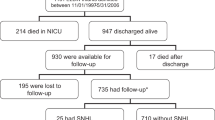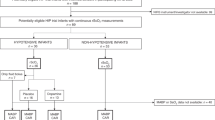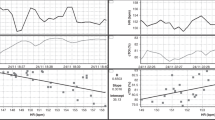Abstract
Objective:
To evaluate, in extremely low gestational age newborns (ELGANs), relationships between indicators of early postnatal hypotension and cranial ultrasound indicators of cerebral white matter damage imaged in the nursery and cerebral palsy diagnoses at 24 months follow-up.
Study Design:
The 1041 infants in this prospective study were born at <28 weeks gestation, were assessed for three indicators of hypotension in the first 24 postnatal hours, had at least one set of protocol cranial ultrasound scans and were evaluated with a structured neurological exam at 24 months corrected age. Indicators of hypotension included: (1) lowest mean arterial pressure (MAP) in the lowest quartile for gestational age; (2) treatment with a vasopressor; and (3) blood pressure lability, defined as the upper quartile of the difference between each infant's lowest and highest MAP. Outcomes included indicators of cerebral white matter damage, that is, moderate/severe ventriculomegaly or an echolucent lesion on cranial ultrasound and cerebral palsy diagnoses at 24 months gestation. Logistic regression was used to evaluate relationships among hypotension indicators and outcomes, adjusting for potential confounders.
Result:
Twenty-one percent of surviving infants had a lowest blood pressure in the lowest quartile for gestational age, 24% were treated with vasopressors and 24% had labile blood pressure. Among infants with these hypotension indicators, 10% percent developed ventriculomegaly and 7% developed an echolucent lesion. At 24 months follow-up, 6% had developed quadriparesis, 4% diparesis and 2% hemiparesis. After adjusting for confounders, we found no association between indicators of hypotension, and indicators of cerebral white matter damage or a cerebral palsy diagnosis.
Conclusion:
The absence of an association between indicators of hypotension and cerebral white matter damage and or cerebral palsy suggests that early hypotension may not be important in the pathogenesis of brain injury in ELGANs.
This is a preview of subscription content, access via your institution
Access options
Subscribe to this journal
Receive 12 print issues and online access
$259.00 per year
only $21.58 per issue
Buy this article
- Purchase on Springer Link
- Instant access to full article PDF
Prices may be subject to local taxes which are calculated during checkout



Similar content being viewed by others
References
Laughon M, Bose C, Allred E, O’Shea TM, Van Marter LJ, Bednarek F et al. Factors associated with treatment for hypotension in extremely low gestational age newborns during the first postnatal week. Pediatrics 2007; 119: 273–280.
du Plessis AJ . The role of systemic hemodynamic disturbances in prematurity-related brain injury. J Child Neurol 2009; 24: 1127–1140.
Weindling AM, Wilkinson AR, Cook J, Calvert SA, Fok TF, Rochefort MJ . Perinatal events which precede periventricular haemorrhage and leukomalacia in the newborn. Br J Obstet Gynaecol 1985; 92: 1218–1223.
Miall-Allen VM, de Vries LS, Whitelaw AG . Mean arterial blood pressure and neonatal cerebral lesions. Arch Dis Child 1987; 62: 1068–1069.
Watkins AM, West CR, Cooke RW . Blood pressure and cerebral haemorrhage and ischaemia in very low birthweight infants. Early Hum Dev 1989; 19: 103–110.
Fok TF, Davies DP, Ng HK . A study of periventricular haemorrhage, post-haemorrhagic ventricular dilatation and periventricular leucomalacia in Chinese preterm infants. J Paediatr Child Health 1990; 26: 271–275.
Low JA, Froese AB, Galbraith RS, Smith JT, Sauerbrei EE, Derrick EJ . The association between preterm newborn hypotension and hypoxemia and outcome during the first year. Acta Paediatr 1993; 82: 433–437.
O’Shea TM, Kothadia JM, Roberts DD, Dillard RG . Perinatal events and the risk of intraparenchymal echodensity in very-low-birthweight neonates. Paediatr Perinat Epidemiol 1998; 12: 408–421.
Kuint J, Barak M, Morag I, Maayan-Metzger A . Early treated hypotension and outcome in very low birth weight infants. Neonatology 2008; 95: 311–316.
Trounce JQ, Shaw DE, Levene MI, Rutter N . Clinical risk factors and periventricular leucomalacia. Arch Dis Child 1988; 63: 17–22.
de Vries LS, Regev R, Dubowitz LM, Whitelaw A, Aber VR . Perinatal risk factors for the development of extensive cystic leukomalacia. Am J Dis Child 1988; 142: 732–735.
Bejar RF, Vaucher YE, Benirschke K, Berry CC . Postnatal white matter necrosis in preterm infants. J Perinatol 1992; 12: 3–8.
Gronlund JU, Korvenranta H, Kero P, Jalonen J, Välimäki IA . Elevated arterial blood pressure is associated with peri-intraventricular haemorrhage. Eur J Pediatr 1994; 153: 836–841.
D’Souza SW, Janakova H, Minors D, Suri R, Waterhouse J, Appleton G et al. Blood pressure, heart rate, and skin temperature in preterm infants: associations with periventricular haemorrhage. Arch Dis Child Fetal Neonatal Ed 1995; 72: F162–F167.
Perlman JM, Risser R, Broyles RS . Bilateral cystic periventricular leukomalacia in the premature infant: associated risk factors. Pediatrics 1996; 97: 822–827.
Wiswell TE, Graziani LJ, Kornhauser MS et al. Effects of hypocarbia on the development of cystic periventricular leukomalacia in premature infants treated with high-frequency jet ventilation. Pediatrics 1996; 98: 918–924.
Baud O, Ville Y, Zupan V, Lacaze-Masmonteil T, Gabilan JC, Frydman R et al. Are neonatal brain lesions due to intrauterine infection related to mode of delivery? Br J Obstet Gynaecol 1998; 105: 121–124.
Cunningham S, Symon AG, Elton RA, Zhu C, McIntosh N . Intra-arterial blood pressure reference ranges, death and morbidity in very low birthweight infants during the first seven days of life. Early Hum Dev 1999; 56: 151–165.
Dammann O, Allred EN, Kuban KC, Van Marter LJ, Pagano M, Sanocka U et al. Systemic hypotension and white-matter damage in preterm infants. Dev Med Child Neurol 2002; 44: 82–90.
Limperopoulos C, Bassan H, Kalish LA, Ringer SA, Eichenwald EC, Walter G et al. Current definitions of hypotension do not predict abnormal cranial ultrasound findings in preterm infants. Pediatrics 2007; 120: 966–977.
Batton B, Zhu X, Fanaroff J, Berlin S, Wilson-Costello D, Walsh M et al. Blood pressure, anti-hypotensive therapy, and neurodevelopment in extremely preterm infants. J Pediatr 2009; 154: 351–357.
Pellicer A, del Carmen Bravo M, Madero R, Salas S, Quero J, Cabañas F . Early systemic hypotension and vasopressor support in low birth weight infants: Impact on neurodevelopment. Pediatrics 2009; 123: 1369–1376.
Goldstein RF, Thompson Jr RJ, Oehler JM, Brazy JE . Influence of acidosis, hypoxemia, and hypotension on neurodevelopmental outcome in very low birth weight infants. Pediatrics 1995; 95: 238–243.
Murphy DJ, Hope PL, Johnson A . Neonatal risk factors for cerebral palsy in very preterm babies: case–control study. BMJ 1997; 314: 404–408.
Hunt RW, Evans N, Rieger I, Kluckow M . Low superior vena cava flow and neurodevelopment at 3 years in very preterm infants. J Pediatr 2004; 145: 588–592.
O’Shea TM, Allred EN, Dammann O, Hirtz D, Kuban KC, Paneth N et al. The ELGAN study of the brain and related disorders in extremely low gestational age newborns. Early Hum Dev 2009; 85: 719–725.
McElrath TF, Hecht JL, Dammann O, Boggess K, Onderdonk A, Markenson G et al. Pregnancy disorders that lead to delivery before the 28th week of gestation: an epidemiologic approach to classification. Am J Epidemiol 2008; 27: 27.
Yudkin PL, Aboualfa M, Eyre JA, Redman CW, Wilkinson AR . New birthweight and head circumference centiles for gestational ages 24 to 42 weeks. Early Hum Dev 1987; 15: 45–52.
Dempsey EM, Barrington KJ . Diagnostic criteria and therapeutic interventions for the hypotensive very low birth weight infant. J Perinatol 2006; 26: 677–681.
O’Shea TM, Kuban KC, Allred EN, Paneth N, Pagano M, Dammann O et al. Neonatal cranial ultrasound lesions and developmental delays at 2 years of age among extremely low gestational age children. Pediatrics 2008; 122: e662–e669.
Kuban KC, Allred EN, O’Shea TM, Paneth N, Pagano M, Dammann O et al. Cranial ultrasound lesions in the NICU predict cerebral palsy at age 2 years in children born at extremely low gestational age. J Child Neurol 2009; 24: 63–72.
Kuban K, Adler I, Allred EN, Bezinque S, Betz BW, Cavenagh E et al. Observer variability assessing US scans of the preterm brain: The ELGAN Study. Pediatr Radiol 2007; 37: 1201–1208.
Kuban KC, O’Shea M, Allred E, Leviton A, Gilmore H, DuPlessis A et al. Video and CD-ROM as a training tool for performing neurologic examinations of 1-year-old children in a multicenter epidemiologic study. J Child Neurol 2005; 20: 829–831.
Kuban KC, Allred EN, O’Shea M, Paneth N, Pagano M, Leviton A et al. An algorithm for identifying and classifying cerebral palsy in young children. J Pediatr 2008; 153: 466–472.
Richardson DK, Corcoran JD, Escobar GJ, Lee SK . SNAP-II and SNAPPE-II: Simplified newborn illness severity and mortality risk scores. J Pediatr 2001; 138: 92–100.
Dempsey EM, Barrington KJ . Evaluation and treatment of hypotension in the preterm infant. Clin Perinatol 2009; 36: 75–85.
Lou HC, Lassen NA, Friis-Hansen B . Low cerebral blood flow in hypotensive perinatal distress. Acta Neurol Scand 1977; 56: 343–352.
Lou HC, Lassen NA, Friis-Hansen B . Impaired autoregulation of cerebral blood flow in the distressed newborn infant. J Pediatr 1979; 94: 118–121.
Leviton A, Pagano M, Kuban KC, Krishnamoorthy KS, Sullivan KF, Allred EN . The epidemiology of germinal matrix hemorrhage during the first half-day of life. Dev Med Child Neurol 1991; 33: 138–145.
Collins MP, Lorenz JM, Jetton JR, Paneth N . Hypocapnia and other ventilation-related risk factors for cerebral palsy in low birth weight infants. Pediatr Res 2001; 50: 712–719.
O’Shea J, Dempsey EM . A comparison of blood pressure measurements in newborns. Am J Perinatol 2009; 26: 113–116.
Troy R, Doron M, Laughon M, Tolleson-Rinehart S, Price W . Comparison of noninvasive and central arterial blood pressure measurements in elbw infants. J Perinatol 2009; 29: 744–749.
Inder TE, Anderson NJ, Spencer C, Wells S, Volpe JJ . White matter injury in the premature infant: a comparison between serial cranial sonographic and MR findings at term. Am J Neuroradiol 2003; 24: 805–809.
Arnold CC, Kramer MS, Hobbs CA, McLean FH, Usher RH . Very low birth weight: a problematic cohort for epidemiologic studies of very small or immature neonates. Am J Epidemiol 1991; 134: 604–613.
Dickersin K . The existence of publication bias and risk factors for its occurrence. JAMA 1990; 263: 1385–1389.
Hall R, de Antueno C, Webber A . Publication bias in the medical literature: a review by a canadian research ethics board. Can J Anaesth 2007; 54: 380–388.
Dempsey EM, Barrington KJ . Treating hypotension in the preterm infant: when and with what: a critical and systematic review. J Perinatol 2007; 27: 469–478.
Author information
Authors and Affiliations
Consortia
Corresponding author
Ethics declarations
Competing interests
This study was supported by a cooperative agreement with the National Institute of Neurological Disorders and Stroke (5U01NS040069-05) and a program project grant from the National Institute of Child Health and Human Development (5P30HD18655). There are no conflict of interest, and no relationships that would in any way influence or bias this study.
Appendix
Appendix
Participating institutions (site principal investigators, sonologists and neuro-developmental examiners).
Baystate Medical Center, Springfield, MA, USA (Bhavesh Shah, Frederick Hampf, Herbert Gilmore, Susan McQuiston).
Beth Israel Deaconess Medical Center, Boston, MA, USA (Camilia R Martin, Jane Share).
Brigham & Women's Hospital, Boston, MA, USA (Linda J Van Marter, Sara Durfee).
Children's Hospital Boston, Boston, MA, USA (Alan Leviton, Kristen Ecklund, Samantha Butler, Haim Bassan, Adré Duplessis, Cecil Hahn, Omar Khwaha, AK Morgan, Janet S Soul).
DeVos Children's Hospital, Grand Rapids, MI, USA (Mariel Portenga, Bradford W Betz, Steven L Bezinque, Joseph Junewick, Wendy Burdo-Hartman, Lynn Fagerman, Kim Lohr, Steve Pastynrnak, Dinah Sutton).
Floating Hospital for Children at Tufts Medical Center, Boston, MA, USA (Cynthia Cole/John Fiascone, Roy McCauley, Paige T Church, Cecelia Keller, Karen Miller).
Massachusetts General Hospital, Boston, MA, USA (Robert Insoft, Kalpathy Krishnamoorthy).
Michigan State Univeristy, East Lansing, MI, USA (Nigel Paneth).
North Carolina Children's Hospital, Chapel Hill, NC, USA (Carl Bose, Lynn A Fordham, Lisa Bostic, Janice Wereszczak, Diane Marshall, Kristi Milowic, Carol Hubbard).
Sparrow Hospital, Lansing, MI, USA (Padmani Karna, Ellen Cavenagh, Victoria J Caine, Padmani Karna, Nicholas Olomu, Joan Price).
University of Chicago Hospital, Chicago, IL, USA (Michael D Schreiber, Kate Feinstein, Leslie Caldarelli, Sunila E O’Conno, Michael Msall, Susan Plesha-Troyke).
University Health Systems of Eastern Carolina, Greenville, NC, USA (Stephen Engelke, Ira Adler, Sharon Buckwald, Rebecca Helms, Kathyrn Kerkering, Scott S MacGilvray, Peter Resnik).
U Mass Memorial Health Center, Worcester, MA, USA (Francis Bednarek, Jacqueline Wellman, Robin Adair, Richard Bream, Alice Miller, Albert Scheiner, Christy Stine).
Wake Forest University Baptist Medical Center and Forsyth Medical Center, Winston-Salem, NC, USA (T Michael O’Shea, Barbara Specter, Deborah Allred, Don Goldstein, Gail Hounshell, Robert Dillard, Cherrie Heller, Debbie Hiatt, Lisa Washburn).
William Beaumont Hospital, Royal Oak, MI, USA (Daniel Batton, Chung-ho Chang, Karen Brooklier, Melisa Oca).
Yale University School of Medicine, New Haven, CT, USA (Richard Ehrenkranz, Cindy Miller, Nancy Close, Elaine Romano, Joanne Williams).
Rights and permissions
About this article
Cite this article
Logan, J., O'Shea, T., Allred, E. et al. Early postnatal hypotension is not associated with indicators of white matter damage or cerebral palsy in extremely low gestational age newborns. J Perinatol 31, 524–534 (2011). https://doi.org/10.1038/jp.2010.201
Received:
Revised:
Accepted:
Published:
Issue Date:
DOI: https://doi.org/10.1038/jp.2010.201
Keywords
This article is cited by
-
Blood pressure values and hypotension management in extremely preterm infants: a multi-center study
Journal of Perinatology (2022)
-
Hemodynamic Quality Improvement Bundle to Reduce the Use of Inotropes in Extreme Preterm Neonates
Pediatric Drugs (2022)
-
Continuous vital sign analysis for predicting and preventing neonatal diseases in the twenty-first century: big data to the forefront
Pediatric Research (2020)
-
Treatment for hypotension in the first 24 postnatal hours and the risk of hearing loss among extremely low birth weight infants
Journal of Perinatology (2020)
-
Early postnatal illness severity scores predict neurodevelopmental impairments at 10 years of age in children born extremely preterm
Journal of Perinatology (2017)



